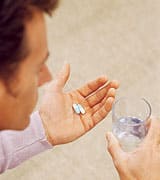Life Extension Magazine®
On December 7, 1941, the Japanese bombed Pearl Harbor. In response to this attack, President Roosevelt declared an emergency and committed every national resource to supporting the war effort. Another significant event occurred in 1941, but no government response was generated. The result of this oversight is that at least twelve times more Americans have died than all the US soldiers killed in World War II. This historic 1941 discovery has been confirmed by recent human studies. It would thus seem appropriate for today’s President to hold a news conference announcing a simple step that every American should take to drastically cut their risk of dying from age-related diseases. When adding up the lives that could be spared, the numbers are staggering. For cancer alone, 275,000 American lives could be saved each year if a nationwide program was implemented. When one considers how much money the government spends to protect against real and imaginary events, the cost of implementing this program would be trivial.
Where You Live Affects Your Cancer RiskIn 1941, the first scientific study was published showing that greater sunlight exposure resulted in lower cancer mortality.1 People living in northern latitudes were shown to contract more cancers than those in southern latitudes, where there is greater year-round sun exposure. Researchers subsequently identified vitamin D as the cancer-protective factor generated from sunlight.2-6 Published scientific studies have shown cancer risk reductions of 50% and more based on higher vitamin D status.7-13 In all, we have identified 89 studies that describe how greater vitamin D levels reduce cancers of the breast, prostate, colon, esophagus, pancreas, ovary, rectum, bladder, kidney, lung and uterus, as well as non-Hodgkin’s lymphoma and multiple myeloma.7-96 What has been lacking up until now, however, has been a double-blind, placebo-controlled study (with strong adherence levels) that specifically measured the effects of higher-dose vitamin D (with calcium) on cancer incidence. American Journal of Clinical Nutrition Publishes Breakthrough StudyIn a report published this year, the effect of administering 1,000 IU/day of vitamin D (with calcium) was evaluated in 1,180 postmenopausal women living in the Midwest.97 Unlike some recent flawed studies, the researchers took extraordinary steps to ensure that study participants were really taking their supplements and that all other variables were tightly controlled. After only four years, the risk of contracting any cancer was 60% lower in the vitamin D (and calcium) group compared with the placebo arm of the study. The scientists then performed an even more detailed analysis of the data. By excluding cancers diagnosed in the first year of the study, which would have included cancers present when participants began taking vitamin D, they found an astounding 77% reduction in cancer incidence in the group receiving vitamin D compared with placebo.97 (Interestingly, in a third arm of this study in which the participants received calcium but no vitamin D, the cancer risk reductions were not as significant.) What this means is that if all Americans began taking just 1,000 IU of vitamin D each day (with calcium), as many as three-quarters of all cancers could be prevented in just four years. The significance of this is such that a national emergency should be called to urge or mandate that all Americans over age 30 take at least 1,000 IU of vitamin D each day. There may not be a better example of what the federal government could do to save American lives than ensuring optimal vitamin D status in all citizens. New findings show that children could also greatly benefit by supplementing with higher doses of vitamin D.98-111
How Vitamin D Prevents CancerCancer has been defined as the “accumulation of mutations in genes that regulate cellular proliferation.” Once genes that regulate cell division mutate, normal cells can turn into cancer cells. Vitamin D has an effect on at least 200 human genes.98 Many of these genes are responsible for regulating cell proliferation, differentiation, and apoptosis. In the next column are simple definitions of these cellular processes: Proliferation: Uncontrolled cell division (cancer cells are characterized by rapid and uncontrolled division). Differentiation: Process that cells undergo to mature into normal cells (uncontrolled reproduction of immature [undifferentiated] cells is a defining feature of cancer). Apoptosis: Natural termination of defective cells (cancer cells are resistant to natural destruction, making them difficult to eradicate). With less than optimal vitamin D status, the genes that regulate the three critical regulatory processes above become defective. These regulatory genes can therefore no longer maintain healthy cellular function (including programmed termination). The result is a sharp increase in cancer risks, as the DNA regulatory genes lack the vitamin D needed to maintain the normal proliferation, differentiation, and apoptosis of our cells. In addition, vitamin D has been shown to help prevent angiogenesis (new blood vessel growth into tumors) and metastasis (spread of cancer).11,51 It is for all these reasons that Life Extension recommended ten years ago that cancer patients take the highest tolerable dose of vitamin D. Vitamin D Prevents Numerous Other DiseasesIf vitamin D only reduced cancer risk, then it would be well worth supplementing with 1,000 IU/day and higher (depending on your level as determined by a blood test). An abundance of recent studies, however, has uncovered a myriad of other diseases that vitamin D helps prevent.113-146 One interesting report showed that elderly people with higher vitamin D levels suffered far fewer falls and were less frail.147 This finding alone points to potentially huge reductions in nursing home confinements, along with less suffering and mortality, if every American adult took 1,000 IU/day of vitamin D. Last year, Life Extension reported that the reason more people develop infections in the winter is not because of cold weather.148 Instead, the reduction in sunlight during winter causes a vitamin D deficiency that impairs immune function.149-159 When one considers that 60,000 Americans perish each year from pneumonia-influenza,160 it becomes apparent that maintaining optimal vitamin D could sharply reduce these grim statistics. Not only is vitamin D required for proper immune function, but by preventing falls and bone fractures, fewer elderly people will succumb to pneumonia as a result of being confined to a hospital setting.
If you’ve ever wondered why so many hospitalized people deteriorate so fast, look no further than the lack of vitamin D that caused their initial problem and the subsequent diminished vitamin D status that occurs in the absence of sunlight in the hospital setting. Chronic inflammation is an underlying factor in the development of numerous age-related diseases. Vitamin D has been shown to suppress pro-inflammatory cytokines and protect against conditions ranging from rheumatoid arthritis, chronic muscle pain, and metabolic syndrome to congestive heart failure and stroke.161-169 Furthermore, those living in higher latitudes contract multiple sclerosis at far higher rates than those who obtain more sunshine throughout the year.138 Scientists have identified specific vitamin D receptors in the white matter of the brain, which may die prematurely in early life if given inadequate vitamin D (resulting in multiple sclerosis).139 So for a nutrient that was once thought to only protect against osteoporosis, vitamin D has emerged as a superstar, which may sharply reduce the risk of most age-related diseases. When looking at all the different lethal diseases that vitamin D has been shown to prevent, hundreds of thousands of lives could be spared each year if every American supplemented with at least 1,000 IU of vitamin D each day. This is why this issue deserves “national emergency” status.
A Historical Precedent for Issuing a National EmergencyPolio was one of the most feared diseases in the first part of the 20th century. The polio virus often attacked children, sometimes leaving them walking on crutches, confined to iron lungs because of pulmonary paralysis, or dead! Dr. Jonas Salk discovered the polio vaccine in 1952. Two years later, a clinical trial was conducted whose scope was unprecedented in medical history. The results were dramatic. Within two hours of announcing the successful clinical trials, the vaccine was licensed for use. Thanks to guarantees from what is now the March of Dimes, vaccine production facilities were already built and ready to operate. In 1955, the vaccine was distributed to children throughout America. In 1952, there were 58,000 cases of polio in the United States—the most ever. By 1964, there were only 121 cases reported. The last case of acquired polio occurred in the United States in 1979.170
Many key players were involved in successfully eradicating the polio virus, including President Franklin D. Roosevelt, who was instrumental in establishing the National Foundation for Infantile Paralysis (known today as the March of Dimes). There is a clear precedent for the federal government to treat today’s epidemic deficiency of vitamin D as a health crisis emergency and take affirmative steps to ensure that every American achieves optimal vitamin D status, just as was done with the polio vaccine in 1955. The reduction in human misery and number of lives saved if all Americans achieved adequate vitamin D status would exceed those saved by the polio vaccine.
| |||||||||||||||||||||||||||||||
Bailing Out MedicareIf one adds up the diseases that vitamin D has been shown to prevent, it becomes clear that if all Americans supplemented with just 1,000 IU of vitamin D (plus calcium) each day, healthcare spending in the United States would plummet. Medicare and some private insurance plans are facing insolvency based on projected healthcare costs that will affect the aging American population. Insolvency would turn into a surplus if vitamin D intake became mandatory. One way of getting vitamin D into almost everyone’s body would be to deny Medicare and other medical insurance disbursements to those whose vitamin D blood levels were severely deficient. This may sound draconian to civil libertarians, but when one considers the dire economic consequences this country faces if healthcare costs are not brought down, mandating vitamin D supplementation would appear to benefit both the health of the citizenry and their pocketbooks. I personally do not want to have to pay more Medicare taxes because some citizens are unwilling to swallow one tiny and inexpensive capsule each day that could dramatically cut their risk of contracting the most dreaded diseases of aging.
Europeans Are Even Worse OffIf you think Americans have a problem, just imagine if the government forbade dietary supplements to contain in excess of 400 IU of vitamin D. In Europe, the upper limit potency is only 400 IU of vitamin D, making it difficult for people there to obtain adequate levels.
A German doctor authored a meticulous review showing significant reductions in cardiovascular disease and diabetes (in children and adults) in response to higher vitamin D status. As cardiovascular disease and diabetes account for up to 50% of all deaths in western countries, this doctor warned of significant health consequences if the pandemic of vitamin D deficiency was not corrected. The German doctor concluded his paper by stating: “Given the high prevalence of insufficient and deficient vitamin D blood concentrations in the general population, an improvement in the population’s vitamin D status must be a major effort for public health service in the future. For that reason, in many countries, legislation has to be changed in order to allow a vitamin D amount in over-the-counter supplements and vitamin D fortified food, which is sufficient to increase serum measurements of vitamin D into the adequate range.”174 My Letter to President BushOn the next page is my letter to our President urging him to take immediate action to ensure that as many Americans as possible know to supplement with at least 1,000 IU of vitamin D3 each day. As I point out, the federal government would save vast amounts on healthcare and disability outlays if it would give lower-income Americans a free bottle containing 365 (1,000 IU) capsules of vitamin D3 each year. I have acquired the knowledge that hundreds of thousands of American lives could be saved each year merely by taking a low-cost vitamin. Not taking affirmative action to eliminate this vitamin deficiency as a cause of disease would be morally reprehensible, ergo my plea to the President to use the resources at his disposal to eradicate today’s epidemic of vitamin D deficiency disease. For longer life, P.S. Please note that in the American Journal of Clinical Nutrition study, each capsule was manufactured to provide 1,100 IU of vitamin D3 to make sure that each participant in the active group received at least 1,000 IU/day of vitamin D. | ||||
| References | ||||
| 1. Apperly F. The relation of solar irradiation to cancer mortality in North America. Cancer Res. 1941;1:191-5. 2. Tuohimaa P, Pukkala E, Scelo G, et al. Does solar exposure, as indicated by the non-melanoma skin cancers, protect from solid cancers: Vitamin D as a possible explanation. Eur J Cancer. 2007 Jul;43(11):1701-12. 3. Grant WB, Strange RC, Garland CF. Sunshine is good medicine. The health benefits of ultraviolet-B induced vitamin D production. J Cosmet Dermatol. 2003 Apr;2(2):86-98. 4. Grant WB, Garland CF, Gorham ED. An estimate of cancer mortality rate reductions in Europe and the US with 1,000 IU of oral vitamin D per day. Recent Results Cancer Res. 2007.174:225-34. 5. Holick MF. Vitamin D: its role in cancer prevention and treatment. Prog Biophys Mol Biol. 2006 Sep;92(1):49-59. 6. Grant WB, Holick MF. Benefits and requirements of vitamin D for optimal health: a review. Altern Med Rev. 2005 Jun;10(2):94-11. 7. Garland CF, Comstock GW, Garland FC, et al. Serum 25-hydroxyvitamin D and colon cancer: eight-year prospective study. Lancet. 1989 Nov 18;2(8673):1176-8. 8. Garland CF, Garland FC, Gorham ED. Can colon cancer incidence and death rates be reduced with calcium and vitamin D? Am J Clin Nutr. 1991 Jul;54(1 Suppl):193S-201S. 9. Garland CF, Gorham ED, Mohr SB, et al. Vitamin D and prevention of breast cancer: pooled analysis. J Steroid Biochem Mol Biol. 2007 Mar;103(3-5):708-11. 10. Gorham ED, Garland CF, Garland FC, et al. Vitamin D and prevention of colorectal cancer. J Steroid Biochem Mol Biol. 2005 Oct;97(1-2):179-94. 11. John EM, Schwartz GG, Koo J, Van Den BD, Ingles SA. Sun exposure, vitamin D receptor gene polymorphisms, and risk of advanced prostate cancer. Cancer Res. 2005 Jun 15;65(12):5470-9. 12. Garland CF, Garland FC, Gorham ED, et al. The role of vitamin D in cancer prevention. Am J Public Health. 2006 Feb;96(2):252-61. 13. Thomas MG. Luminal and humoral influences on human rectal epithelial cytokinetics. Ann R Coll Surg Engl. 1995 Mar;77(2):85-9. 14. Garland FC, Garland CF, Gorham ED, Young JF. Geographic variation in breast cancer mortality in the United States: a hypothesis involving exposure to solar radiation. Prev Med. 1990 Nov;19(6):614-22. 15. Bertone-Johnson ER, Chen WY, Holick MF, et al. Plasma 25-hydroxyvitamin D and 1,25-dihydroxyvitamin D and risk of breast cancer. Cancer Epidemiol Biomarkers Prev. 2005 Aug;14(8):1991-7. 16. Berube S, Diorio C, Verhoek-Oftedahl W, Brisson J. Vitamin D, calcium, and mammographic breast densities. Cancer Epidemiol Biomarkers Prev. 2004 Sep;13(9):1466-72. 17. Jensen SS, Madsen MW, Lukas J, Binderup L, Bartek J. Inhibitory effects of 1alpha,25-dihydroxyvitamin D(3) on the G(1)-S phase-controlling machinery. Mol Endocrinol. 2001 Aug;15(8):1370-80. 18. Lowe L, Hansen CM, Senaratne S, Colston KW. Mechanisms implicated in the growth regulatory effects of vitamin D compounds in breast cancer cells. Recent Results Cancer Res. 2003;164:99-110. 19. Swami S, Raghavachari N, Muller UR, Bao YP, Feldman D. Vitamin D growth inhibition of breast cancer cells: gene expression patterns assessed by cDNA microarray. Breast Cancer Res Treat. 2003 Jul;80(1):49-62. 20. Colston KW, Hansen CM. Mechanisms implicated in the growth regulatory effects of vitamin D in breast cancer. Endocr Relat Cancer. 2002 Mar;9(1):45-59. 21. Weitsman GE, Koren R, Zuck E, et al. Vitamin D sensitizes breast cancer cells to the action of H2O2: mitochondria as a convergence point in the death pathway. Free Radic Biol Med. 2005 Jul 15;39(2):266-78. 22. Welsh J. Vitamin D and breast cancer: insights from animal models. Am J Clin Nutr. 2004 Dec;80(6 Suppl):1721S-4S. 23. Christakos S. Vitamin D and breast cancer. Adv Exp Med Biol. 1994;364:115-8. 24. Cui Y, Rohan TE. Vitamin D, calcium, and breast cancer risk: a review. Cancer Epidemiol Biomarkers Prev. 2006 Aug;15(8):1427-37. 25. Peng X, Mehta RG. Differential expression of prohibitin is correlated with dual action of Vitamin D as a proliferative and antiproliferative hormone in breast epithelial cells. J Steroid Biochem Mol Biol. 2007 Mar;103(3-5):446-50. 26. Sundaram S, Beckman MJ, Bajwa A, et al. QW-1624F2-2, a synthetic analogue of 1,25-dihydroxyvitamin D3, enhances the response to other deltanoids and suppresses the invasiveness of human metastatic breast tumor cells. Mol Cancer Ther. 2006 Nov;5(11):2806-14. 27. Friedrich M, Diesing D, Cordes T, et al. Analysis of 25-hydroxyvitamin D3-1alpha-hydroxylase in normal and malignant breast tissue. Anticancer Res. 2006 Jul;26(4A):2615-20. 28. Colston KW, Lowe LC, Mansi JL, Campbell MJ. Vitamin D status and breast cancer risk. Anticancer Res. 2006 Jul;26(4A):2573-80. 29. Peng X, Mehta R, Wang S, Chellappan S, Mehta RG. Prohibitin is a novel target gene of vitamin D involved in its antiproliferative action in breast cancer cells. Cancer Res. 2006 Jul 15;66(14):7361-9. 30. Lee HJ, Liu H, Goodman C, et al. Gene expression profiling changes induced by a novel Gemini Vitamin D derivative during the progression of breast cancer. Biochem Pharmacol. 2006 Jul 28;72(3):332-43. 31. Kemmis CM, Salvador SM, Smith KM, Welsh J. Human mammary epithelial cells express CYP27B1 and are growth inhibited by 25-hydroxyvitamin D-3, the major circulating form of vitamin D-3. J Nutr. 2006 Apr;136(4):887-92. 32. Kawata H, Kamiakito T, Takayashiki N, Tanaka A. Vitamin D3 suppresses the androgen-stimulated growth of mouse mammary carcinoma SC-3 cells by transcriptional repression of fibroblast growth factor 8. J Cell Physiol. 2006 Jun;207(3):793-9. 33. Hussain-Hakimjee EA, Peng X, Mehta RR, Mehta RG. Growth inhibition of carcinogen-transformed MCF-12F breast epithelial cells and hormone-sensitive BT-474 breast cancer cells by 1alpha-hydroxyvitamin D5. Carcinogenesis. 2006 Mar;27(3):551-9. 34. Lin J, Manson JE, Lee IM, et al. Intakes of calcium and vitamin D and breast cancer risk in women. Arch Intern Med. 2007 May 28;167(10):1050-9. 35. Ahonen MH, Tenkanen L, Teppo L, Hakama M, Tuohimaa P. Prostate cancer risk and prediagnostic serum 25-hydroxyvitamin D levels (Finland). Cancer Causes Control. 2000 Oct;11(9):847-52. 36. Gross MD. Vitamin D and calcium in the prevention of prostate and colon cancer: new approaches for the identification of needs. J Nutr. 2005 Feb;135(2):326-31. 37. Luscombe CJ, Fryer AA, French ME, et al. Exposure to ultraviolet radiation: association with susceptibility and age at presentation with prostate cancer. Lancet. 2001 Aug 25;358(9282):641-2. 38. Polek TC, Weigel NL. Vitamin D and prostate cancer. J Androl. 2002 Jan;23(1):9-17. 39. Lou YR, Qiao S, Talonpoika R, Syvala H, Tuohimaa P. The role of Vitamin D3 metabolism in prostate cancer. J Steroid Biochem Mol Biol. 2004 Nov;92(4):317-25. 40. Woo TC, Choo R, Jamieson M, Chander S, Vieth R. Pilot study: potential role of vitamin D (Cholecalciferol) in patients with PSA relapse after definitive therapy. Nutr Cancer. 2005;51(1):32-6. 41. Schwartz GG, Hulka BS. Is vitamin D deficiency a risk factor for prostate cancer? (Hypothesis). Anticancer Res. 1990 Sep;10(5A):1307-11. 42. Grant WB. A multicountry ecologic study of risk and risk reduction factors for prostate cancer mortality. Eur Urol. 2004 Mar;45(3):271-9. 43. Gross C, Stamey T, Hancock S, Feldman D. Treatment of early recurrent prostate cancer with 1,25-dihydroxyvitamin D3 (calcitriol). J Urol. 1998 Jun;159(6):2035-9. 44. Beer TM, Lemmon D, Lowe BA, Henner WD. High-dose weekly oral calcitriol in patients with a rising PSA after prostatectomy or radiation for prostate carcinoma. Cancer. 2003 Mar 1;97(5):1217-24. 45. Beer TM, Eilers KM, Garzotto M, et al. Weekly high-dose calcitriol and docetaxel in metastatic androgen-independent prostate cancer. J Clin Oncol. 2003 Jan 1;21(1):123-8. 46. Swami S, Krishnan AV, Moreno J, et al. Calcitriol and genistein actions to inhibit the prostaglandin pathway: potential combination therapy to treat prostate cancer. J Nutr. 2007 Jan;137(1 Suppl):205S-10S. 47. Flanagan JN, Young MV, Persons KS, et al. Vitamin D metabolism in human prostate cells: implications for prostate cancer chemoprevention by vitamin D. Anticancer Res. 2006 Jul;26(4A):2567-72. 48. Huang YC, Hung WC. 1,25-dihydroxyvitamin D3 transcriptionally represses p45Skp2 expression via the Sp1 sites in human prostate cancer cells. J Cell Physiol. 2006 Nov;209(2):363-9. 49. Moreno J, Krishnan AV, Peehl DM, Feldman D. Mechanisms of vitamin D-mediated growth inhibition in prostate cancer cells: inhibition of the prostaglandin pathway. Anticancer Res. 2006 Jul;26(4A):2525-30. 50. Lambert JR, Kelly JA, Shim M, et al. Prostate derived factor in human prostate cancer cells: gene induction by vitamin D via a p53-dependent mechanism and inhibition of prostate cancer cell growth. J Cell Physiol. 2006 Sep;208(3):566-74. 51. Bao BY, Yao J, Lee YF. 1alpha, 25-dihydroxyvitamin D3 suppresses interleukin-8-mediated prostate cancer cell angiogenesis. Carcinogenesis. 2006 Sep;27(9):1883-93. 52. Lou YR, Tuohimaa P. Androgen enhances the antiproliferative activity of vitamin D3 by suppressing 24-hydroxylase expression in LNCaP cells. J Steroid Biochem Mol Biol. 2006 Apr;99(1):44-9. 53. Yee SW, Campbell MJ, Simons C. Inhibition of Vitamin D3 metabolism enhances VDR signalling in androgen-independent prostate cancer cells. J Steroid Biochem Mol Biol. 2006 Mar;98(4-5):228-35. 54. Tokar EJ, Webber MM. Cholecalciferol (vitamin D3) inhibits growth and invasion by up-regulating nuclear receptors and 25-hydroxylase (CYP27A1) in human prostate cancer cells. Clin Exp Metastasis. 2005;22(3):275-84. 55. Beer TM, Myrthue A. Calcitriol in the treatment of prostate cancer. Anticancer Res. 2006 Jul;26(4A):2647-51. 56. Li H, Stampfer MJ, Hollis JB, et al. A Prospective Study of Plasma Vitamin D Metabolites, Vitamin D Receptor Polymorphisms, and Prostate Cancer. PLoS Med. 2007 Mar 20;4(3):e103. 57. Medeiros R, Morais A, Vasconcelos A, et al. The role of vitamin D receptor gene polymorphisms in the susceptibility to prostate cancer of a southern European population. J Hum Genet. 2002;47(8):413-8. 58. Hartman TJ, Albert PS, Snyder K, et al. The association of calcium and vitamin D with risk of colorectal adenomas. J Nutr. 2005 Feb;135(2):252-9. 59. Gorham ED, Garland CF, Garland FC, et al. Optimal vitamin D status for colorectal cancer prevention: a quantitative meta analysis. Am J Prev Med. 2007 Mar;32(3):210-6. 60. Park SY, Murphy SP, Wilkens LR, et al. Calcium and vitamin D intake and risk of colorectal cancer: the Multiethnic Cohort Study. Am J Epidemiol. 2007 Apr 1;165(7):784-93. 61. Garland CF, Garland FC. Do sunlight and vitamin D reduce the likelihood of colon cancer? Int J Epidemiol. 2006 Apr;35(2):217-20. 62. Feskanich D, Ma J, Fuchs CS, et al. Plasma vitamin D metabolites and risk of colorectal cancer in women. Cancer Epidemiol Biomarkers Prev. 2004 Sep;13(9):1502-8. 63. Giovannucci E. The epidemiology of vitamin D and cancer incidence and mortality: a review (United States). Cancer Causes Control. 2005 Mar;16(2):83-95. 64. Giovannucci E. The epidemiology of vitamin D and colorectal cancer: recent findings. Curr Opin Gastroenterol. 2006 Jan;22(1):24-9. 65. Garland C, Shekelle RB, Barrett-Connor E, et al. Dietary vitamin D and calcium and risk of colorectal cancer: a 19-year prospective study in men. Lancet. 1985 Feb 9;1(8424):307-9. 66. Koren R, Wacksberg S, Weitsman GE, Ravid A. Calcitriol sensitizes colon cancer cells to H2O2-induced cytotoxicity while inhibiting caspase activation. J Steroid Biochem Mol Biol. 2006 Oct;101(2-3):151-60. 67. Grau MV, Baron JA, Sandler RS, et al. Vitamin D, calcium supplementation, and colorectal adenomas: results of a randomized trial. J Natl Cancer Inst. 2003 Dec 3;95(23):1765-71. 68. Holt PR, Bresalier RS, Ma CK, et al. Calcium plus vitamin D alters preneoplastic features of colorectal adenomas and rectal mucosa. Cancer. 2006 Jan 15;106(2):287-96. 69. Murillo G, Matusiak D, Benya RV, Mehta RG. Chemopreventive efficacy of 25-hydroxyvitamin D3 in colon cancer. J Steroid Biochem Mol Biol. 2007 Mar;103(3-5):763-7. 70. Kim KE, Brasitus TA. The role of vitamin D in normal and pathologic processes in the colon. Curr Opin Gastroenterol. 2001 Jan;17(1):72-7. 71. Gonzalez-Sancho JM, Larriba MJ, Ordonez-Moran P, Palmer HG, Munoz A. Effects of 1alpha,25-dihydroxyvitamin D3 in human colon cancer cells. Anticancer Res. 2006 Jul;26(4A):2669-81. 72. Froicu M, Cantorna MT. Vitamin D and the vitamin D receptor are critical for control of the innate immune response to colonic injury. BMC Immunol. 2007;85. 73. Lieberman DA, Prindiville S, Weiss DG, Willett W. Risk factors for advanced colonic neoplasia and hyperplastic polyps in asymptomatic individuals. JAMA. 2003 Dec 10;290(22):2959-67. 74. Giovannucci E, Liu Y, Rimm EB, et al. Prospective study of predictors of vitamin D status and cancer incidence and mortality in men. J Natl Cancer Inst. 2006 Apr 5;98(7):451-9. 75. Skinner HG, Michaud DS, Giovannucci E, et al. Vitamin D intake and the risk for pancreatic cancer in two cohort studies. Cancer Epidemiol Biomarkers Prev. 2006 Sep;15(9):1688-95. 76. Zhang X, Nicosia SV, Bai W. Vitamin D receptor is a novel drug target for ovarian cancer treatment. Curr Cancer Drug Targets. 2006 May;6(3):229-44. 77. Lefkowitz ES, Garland CF. Sunlight, vitamin D, and ovarian cancer mortality rates in US women. Int J Epidemiol. 1994 Dec;23(6):1133-6. 78. Konety BR, Lavelle JP, Pirtskalaishvili G, et al. Effects of vitamin D (calcitriol) on transitional cell carcinoma of the bladder in vitro and in vivo. J Urol. 2001 Jan;165(1):253-8. 79. London GM, Guerin AP, Verbeke FH, et al. Mineral metabolism and arterial functions in end-stage renal disease: potential role of 25-hydroxyvitamin D deficiency. J Am Soc Nephrol. 2007 Feb;18(2):613-20. 80. Liu W, Tretiakova M, Kong J, et al. Expression of vitamin D3 receptor in kidney tumors. Hum Pathol. 2006 Oct;37(10):1268-78. 81. Taskapan H, Wei M, Oreopoulos DG. 25(OH) vitamin D3 in patients with chronic kidney disease and those on dialysis: rediscovering its importance. Int Urol Nephrol. 2006;38(2):323-9. 82. Nasri H, Baradaran A. The influence of serum 25-hydroxy vitamin D levels on Helicobacter Pylori Infections in patients with end-stage renal failure on regular hemodialysis. Saudi J Kidney Dis Transpl. 2007 Jun;18(2):215-9. 83. Hamano T. Vitamin D deficiency in CKD patients. Clin Calcium. 2007 May;17(5):718-24. 84. Hamada Y, Fukagawa M. The pleiotropic effects of vitamin D on kidney disease. Clin Calcium. 2007 May;17(5):712-7. 85. Khan S. Vitamin D deficiency and secondary hyperparathyroidism among patients with chronic kidney disease. Am J Med Sci. 2007 Apr;333(4):201-7. 86. Mernitz H, Smith DE, Wood RJ, Russell RM, Wang XD. Inhibition of lung carcinogenesis by 1alpha,25-dihydroxyvitamin D3 and 9-cis retinoic acid in the A/J mouse model: evidence of retinoid mitigation of vitamin D toxicity. Int J Cancer. 2007 Apr 1;120(7):1402-9. 87. van den Bemd GJ, Chang GT. Vitamin D and vitamin D analogs in cancer treatment. Curr Drug Targets. 2002 Feb;3(1):85-94. 88. Porojnicu AC, Robsahm TE, Dahlback A, et al. Seasonal and geographical variations in lung cancer prognosis in Norway. Does Vitamin D from the sun play a role? Lung Cancer. 2007 Mar;55(3):263-70. 89. Becker S, Cordes T, Diesing D, Diedrich K, Friedrich M. Expression of 25 hydroxyvitamin D3-1alpha-hydroxylase in human endometrial tissue. J Steroid Biochem Mol Biol. 2007 Mar;103(3-5):771-5. 90. Friedrich M, Rafi L, Mitschele T, et al. Analysis of the vitamin D system in cervical carcinomas, breast cancer and ovarian cancer. Recent Results Cancer Res. 2003;164:239-46. 91. Polesel J, Talamini R, Montella M, et al. Linoleic acid, vitamin D and other nutrient intakes in the risk of non-Hodgkin lymphoma: an Italian case-control study. Ann Oncol. 2006 Apr;17(4):713-8. 92. Armstrong BK, Kricker A. Sun exposure and non-Hodgkin lymphoma. Cancer Epidemiol Biomarkers Prev. 2007 Mar;16(3):396-400. 93. Mullin GE, Dobs A. Vitamin d and its role in cancer and immunity: a prescription for sunlight. Nutr Clin Pract. 2007 Jun;22(3):305-22. 94. Park WH, Seol JG, Kim ES, et al. Cell cycle arrest induced by the vitamin D(3) analog EB1089 in NCI-H929 myeloma cells is associated with induction of the cyclin-dependent kinase inhibitor p27. Exp Cell Res. 2000 Feb 1;254(2):279-86. 95. Ozdemir F, Esen N, Ovali E, et al. Effects of dexamethasone, all-trans retinoic acid, vitamin D(3) and interferon-alpha on FO myeloma cells. Chemotherapy. 2004 Oct;50(4):190-3. 96. Imseis RE, Palmieri GM, Holbert JM, Leventhal MR, Sebes JI. Effect of calcitriol and pamidronate in multiple myeloma. Am J Med Sci. 1999 Jul;318(1):61-6. 97. Lappe JM, Travers-Gustafson D, Davies KM, Recker RR, Heaney RP. Vitamin D and calcium supplementation reduces cancer risk: results of a randomized trial. Am J Clin Nutr. 2007 Jun;85(6):1586-91. 98. Holick MF. Vitamin D deficiency. N Engl J Med. 2007 Jul 19;357(3):266-81. 99. Weng FL, Shults J, Leonard MB, Stallings VA, Zemel BS. Risk factors for low serum 25-hydroxyvitamin D concentrations in otherwise healthy children and adolescents. Am J Clin Nutr. 2007 Jul;86(1):150-8. 100. Silk H, Thiede S, Trojian T. Counseling about vitamin D supplementation for infants: results of a survey of pediatric and family medicine physicians in Connecticut. Conn Med. 2007 Mar;71(3):133-7. 101. Cashman KD. Vitamin D in childhood and adolescence. Postgrad Med J. 2007 Apr;83(978):230-5. 102. Lee JM, Smith JR, Philipp BL, et al. Vitamin D deficiency in a healthy group of mothers and newborn infants. Clin Pediatr (Phila). 2007 Jan;46(1):42-4. 103. Piirainen T, Laitinen K, Isolauri E. Impact of national fortification of fluid milks and margarines with vitamin D on dietary intake and serum 25-hydroxyvitamin D concentration in 4-year-old children. Eur J Clin Nutr. 2007 Jan;61(1):123-8. 104. Pappa HM, Gordon CM, Saslowsky TM, et al. Vitamin D status in children and young adults with inflammatory bowel disease. Pediatrics. 2006 Nov;118(5):1950-61. 105. Harkness LS, Cromer BA. Vitamin D deficiency in adolescent females. J Adolesc Health. 2005 Jul;37(1):75. 106. Sullivan SS, Rosen CJ, Halteman WA, Chen TC, Holick MF. Adolescent girls in Maine are at risk for vitamin D insufficiency. J Am Diet Assoc. 2005 Jun;105(6):971-4. 107. Gordon CM, DePeter KC, Feldman HA, Grace E, Emans SJ. Prevalence of vitamin D deficiency among healthy adolescents. Arch Pediatr Adolesc Med. 2004 Jun;158(6):531-7. 108. Gessner BD, Plotnik J, Muth PT. 25-hydroxyvitamin D levels among healthy children in Alaska. J Pediatr. 2003 Oct;143(4):434-7. 109. Wharton B, Bishop N. Rickets. Lancet. 2003 Oct 25;362(9393):1389-400. 110. Biser-Rohrbaugh A, Hadley-Miller N. Vitamin d deficiency in breast-fed toddlers. J Pediatr Orthop. 2001 Jul;21(4):508-11. 111. Shah M, Salhab N, Patterson D, Seikaly MG. Nutritional rickets still afflict children in north Texas. Tex Med. 2000 Jun;96(6):64-8. 112. Tworoger SS, Lee IM, Buring JE, Rosner B, Hollis BW, Hankinson SE. Plasma 25-hydroxyvitamin D and 1,25-dihydroxyvitamin D and risk of incident ovarian cancer. Cancer Epidemiol Biomarkers Prev. 2007 Apr;16(4):783-8. 113. Hanley DA, Davison KS. Vitamin D insufficiency in North America. J Nutr. 2005 Feb;135(2):332-7. 114. Hollis BW. Circulating 25-hydroxyvitamin D levels indicative of vitamin D sufficiency: implications for establishing a new effective dietary intake recommendation for vitamin D. J Nutr. 2005 Feb;135(2):317-22. 115. Holick MF. High prevalence of vitamin D inadequacy and implications for health. Mayo Clin Proc. 2006 Mar;81(3):353-73. 116. Calvo MS, Whiting SJ. Prevalence of vitamin D insufficiency in Canada and the United States: importance to health status and efficacy of current food fortification and dietary supplement use. Nutr Rev. 2003 Mar;61(3):107-13. 117. Lappe JM, Davies KM, Travers-Gustafson D, Heaney RP. Vitamin D status in a rural postmenopausal female population. J Am Coll Nutr. 2006 Oct;25(5):395-402. 118. Weaver CM, Fleet JC. Vitamin D requirements: current and future. Am J Clin Nutr. 2004 Dec;80(6 Suppl):1735S-9S. 119. Holick MF. The vitamin D epidemic and its health consequences. J Nutr. 2005 Nov;135(11):2739S-48S. 120. Whiting SJ, Calvo MS. Dietary recommendations for vitamin D: a critical need for functional end points to establish an estimated average requirement. J Nutr. 2005 Feb;135(2):304-9. 121. Holick MF. Vitamin D: importance in the prevention of cancers, type 1 diabetes, heart disease, and osteoporosis. Am J Clin Nutr. 2004 Mar;79(3):362-71. 122. Bodnar LM, Simhan HN, Powers RW, et al. High prevalence of vitamin D insufficiency in black and white pregnant women residing in the northern United States and their neonates. J Nutr. 2007 Feb;137(2):447-52. 123. Houston DK, Cesari M, Ferrucci L, et al. Association between vitamin D status and physical performance: the InCHIANTI study. J Gerontol A Biol Sci Med Sci. 2007 Apr;62(4):440-6. 124. Pittas AG, Lau J, Hu FB, wson-Hughes B. The role of vitamin D and calcium in type 2 diabetes. A systematic review and meta-analysis. J Clin Endocrinol Metab. 2007 Jun;92(6):2017-29. 125. Harris SS. Vitamin D in type 1 diabetes prevention. J Nutr. 2005 Feb;135(2):323-5. 126. Chiu KC, Chu A, Go VL, Saad MF. Hypovitaminosis D is associated with insulin resistance and beta cell dysfunction. Am J Clin Nutr. 2004 May;79(5):820-5. 127. Hypponen E. Micronutrients and the risk of type 1 diabetes: vitamin D, vitamin E, and nicotinamide. Nutr Rev. 2004 Sep;62(9):340-7. 128. Gysemans CA, Cardozo AK, Callewaert H, et al. 1,25-Dihydroxyvitamin D3 modulates expression of chemokines and cytokines in pancreatic islets: implications for prevention of diabetes in nonobese diabetic mice. Endocrinology. 2005 Apr;146(4):1956-64. 129. Hypponen E, Laara E, Reunanen A, Jarvelin MR, Virtanen SM. Intake of vitamin D and risk of type 1 diabetes: a birth-cohort study. Lancet. 2001 Nov 3;358(9292):1500-3. 130. Mosekilde L. Vitamin D and the elderly. Clin Endocrinol (Oxf). 2005 Mar;62(3):265-81. 131. Lips P. Vitamin D deficiency and secondary hyperparathyroidism in the elderly: consequences for bone loss and fractures and therapeutic implications. Endocr Rev. 2001 Aug;22(4):477-501. 132. Harris SS, Soteriades E, Coolidge JA, Mudgal S, wson-Hughes B. Vitamin D insufficiency and hyperparathyroidism in a low income, multiracial, elderly population. J Clin Endocrinol Metab. 2000 Nov;85(11):4125-30. 133. Heaney RP. Long-latency deficiency disease: insights from calcium and vitamin D. Am.J Clin Nutr. 2003 Nov;78(5):912-9. 134. Chapuy MC, Pamphile R, Paris E, et al. Combined calcium and vitamin D3 supplementation in elderly women: confirmation of reversal of secondary hyperparathyroidism and hip fracture risk: the Decalyos II study. Osteoporos Int. 2002 Mar;13(3):257-64. 135. Lammert M, Friedman JM, Roth HJ, et al. Vitamin D deficiency associated with number of neurofibromas in neurofibromatosis 1. J Med Genet. 2006 Oct;43(10):810-3. 136. Kutuzova GD, DeLuca HF. 1,25-Dihydroxyvitamin D3 regulates genes responsible for detoxification in intestine. Toxicol Appl Pharmacol. 2007 Jan 1;218(1):37-44. 137. Hayes CE, Cantorna MT, DeLuca HF. Vitamin D and multiple sclerosis. Proc Soc Exp Biol Med. 1997 Oct;216(1):21-7. 138. Franklin GM, Nelson L. Environmental risk factors in multiple sclerosis: causes, triggers, and patient autonomy. Neurology. 2003 Oct 28;61(8):1032-4. 139. Chaudhuri A. Why we should offer routine vitamin D supplementation in pregnancy and childhood to prevent multiple sclerosis. Med Hypotheses. 2005;64(3):608-18. 140. VanAmerongen BM, Dijkstra CD, Lips P, Polman CH. Multiple sclerosis and vitamin D: an update. Eur J Clin Nutr . 2004 Aug;58(8):1095-109. 141. Calvo MS, Whiting SJ. Overview of the proceedings from Experimental Biology 2004 symposium: vitamin D insufficiency: a significant risk factor in chronic diseases and potential disease-specific biomarkers of vitamin D sufficiency. J Nutr. 2005 Feb;135(2):301-3. 142. Talalaj M, Kapitan-Malinowska B, Debski K, et al. Administration of 1 alpha-OH vitamin D3 and calcium prevents bone mass loss in patients with advanced prostatic carcinoma after orchidectomy treated with complete androgenic blockade. Endokrynol Pol. 2005 May;56(3):225-32. 143. Munger KL, Levin LI, Hollis BW, Howard NS, Ascherio A. Serum 25-hydroxyvitamin D levels and risk of multiple sclerosis. JAMA. 2006 Dec 20;296(23):2832-8. 144. Parekh N, Chappell RJ, Millen AE, Albert DM, Mares JA. Association between vitamin D and age-related macular degeneration in the Third National Health and Nutrition Examination Survey, 1988 through 1994. Arch Ophthalmol. 2007 May;125(5):661-9. 145. Lehmann B. The vitamin D3 pathway in human skin and its role for regulation of biological processes. Photochem Photobiol. 2005 Nov;81(6):1246-51. 146. Wolters M. Diet and psoriasis: experimental data and clinical evidence. Br J Dermatol. 2005 Oct;153(4):706-14. 147. Broe KE, Chen TC, Weinberg J, et al. A higher dose of vitamin d reduces the risk of falls in nursing home residents: a randomized, multiple-dose study. J Am Geriatr Soc. 2007 Feb;55(2):234-9. 148. Available at: http://www.lifeextension.com/magazine/mag2007_report_vitamind_01.html. Accessed July 17, 2007. 149. Holick MF. Sunlight and vitamin D for bone health and prevention of autoimmune diseases, cancers, and cardiovascular disease. Am J Clin Nutr. 2004 Dec;80(6 Suppl):1678S-88S. 150. Liu PT, Stenger S, Li H, et al. Toll-like receptor triggering of a vitamin D-mediated human antimicrobial response. Science. 2006 Mar 24;311(5768):1770-3. 151. May E, Asadullah K, Zugel U. Immunoregulation through 1,25-dihydroxyvitamin D3 and its analogs. Curr Drug Targets Inflamm Allergy. 2004 Dec;3(4):377-93. 152. van EE, Mathieu C. Immunoregulation by 1,25-dihydroxyvitamin D3: basic concepts. J Steroid Biochem Mol Biol. 2005 Oct;97 (1-2):93-101. 153. Cannell JJ, Vieth R, Umhau JC, et al. Epidemic influenza and vitamin D. Epidemiol Infect. 2006 Dec;134(6):1129-40. 154. Quesada JM, Serrano I, Borrego F, et al. Calcitriol effect on natural killer cells from hemodialyzed and normal subjects. Calcif Tissue Int. 1995 Feb;56(2):113-7. 155. Amento EP. Vitamin D and the immune system. Steroids. 1987 Jan;49(1-3):55-72. 156. Hayes CE, Nashold FE, Spach KM, Pedersen LB. The immunological functions of the vitamin D endocrine system. Cell Mol Biol (Noisy.-le-grand). 2003 Mar;49(2):277-300. 157. Heaney RP, Davies KM, Chen TC, Holick MF, Barger-Lux MJ. Human serum 25-hydroxycholecalciferol response to extended oral dosing with cholecalciferol. Am J Clin Nutr. 2003 Jan;77(1):204-10. 158. Meier C, Woitge HW, Witte K, Lemmer B, Seibel MJ. Supplementation with oral vitamin D3 and calcium during winter prevents seasonal bone loss: a randomized controlled open-label prospective trial. J Bone Miner Res. 2004 Aug;19(8):1221-30. 159. Grant WB. An estimate of premature cancer mortality in the U.S. due to inadequate doses of solar ultraviolet-B radiation. Cancer. 2002 Mar 15;94(6):1867-75. 160. Hoyert DL, Heron MP, Murphy SL, Kung HC. Deaths: final data for 2003. Natl Vital Stat Rep. 2006 Apr 19;54(13):1-120. 161. Holick MF. Vitamin D: important for prevention of osteoporosis, cardiovascular heart disease, type 1 diabetes, autoimmune diseases, and some cancers. South Med J. 2005 Oct;98(10):1024-7. 162. Miggiano GA, Gagliardi L. Diet, nutrition and rheumatoid arthritis. Clin Ter. 2005 May;156(3):115-23. 163. Plotnikoff GA, Quigley JM. Prevalence of severe hypovitaminosis D in patients with persistent, nonspecific musculoskeletal pain. Mayo Clin Proc. 2003 Dec;78(12):1463-70. 164. Liu S, Song Y, Ford ES et al. Dietary calcium, vitamin D, and the prevalence of metabolic syndrome in middle-aged and older US. women. Diabetes Care. 2005 Dec;28(12):2926-32. 165. Sanz J, Moreno PR, Fuster V. Update on advances in atherothrombosis. Nat Clin Pract Cardiovasc Med. 2007 Feb;4(2):78-89. 166. de Ferranti SD, Rifai N. C-reactive protein: a nontraditional serum marker of cardiovascular risk. Cardiovasc Pathol. 2007 Jan;16(1):14-21. 167. Witte KK, Nikitin NP, Parker AC, et al. The effect of micronutrient supplementation on quality-of-life and left ventricular function in elderly patients with chronic heart failure. Eur Heart J. 2005 Nov;26(21):2238-44. 168. Schleithoff SS, Zittermann A, Tenderich G, et al. Vitamin D supplementation improves cytokine profiles in patients with congestive heart failure: a double-blind, randomized, placebo-controlled trial. Am J Clin Nutr. 2006 Apr;83(4):754-9. 169. Marniemi J, Alanen E, Impivaara O, et al. Dietary and serum vitamins and minerals as predictors of myocardial infarction and stroke in elderly subjects. Nutr Metab Cardiovasc Dis. 2005 Jun;15(3):188-97. 170. Available at: http://www.cdc.gov/vaccines/events/polio-vacc-50th/timeline.htm. Accessed July 17, 2007. 171. Binkley N, Novotny R, Krueger D, et al. Low vitamin D status despite abundant sun exposure. J Clin Endocrinol Metab. 2007 Jun;92(6):2130-35. 172. Barger-Lux MJ, Heaney RP, Dowell S, Chen TC, Holick MF. Vitamin D and its major metabolites: serum levels after graded oral dosing in healthy men. Osteoporos Int. 1998;8(3):222-30. 173. Byrne PM, Freaney R, McKenna MJ. Vitamin D supplementation in the elderly: review of safety and effectiveness of different regimes. Calcif Tissue Int. 1995 Jun;56(6):518-20. 174. Zittermann A. Vitamin D and disease prevention with special reference to cardiovascular disease. Prog Biophys Mol Biol. 2006 Sep;92(1):39-48. 175. Vieth R, Bischoff-Ferrari H, Boucher BJ, et al. The urgent need to recommend an intake of vitamin D that is effective. Am J Clin Nutr. 2007 Mar;85(3):649-50. |
| President George Bush Dear President Bush: In 2003, your office had the foresight to urge all Americans to increase their consumption of omega-3 fatty acids and decrease their intake of trans fats. In the ensuing years, several hundred scientific studies have further substantiated the health benefits associated with greater omega-3 consumption, and many food producers now state “no trans fats” on their label. The human research into vitamin D has now reached a point where we can predictably state that several hundred thousand American lives each year could be saved if every citizen supplemented their diet with 1,000 IU of vitamin D each day. Please review with your advisors the materials I have attached and consider implementing the following immediate strategy:
Then work with your advisors in devising a strategy to mandate that anyone expecting to file a claim with Medicare, Medicaid, or any other government-funded healthcare agency must take at least 1,000 IU of vitamin D3 each day. A blood test can be used to ascertain whether a person is really supplementing with vitamin D3. If some individuals cannot afford this very low-cost supplement (less than $19 a year), it would be in the federal government’s economic interest to give low-income Americans a free bottle each year containing 365 (1,000 IU) capsules of vitamin D3. Based on our analysis of the reductions in disease incidence that would result from universal supplementation with 1,000 IU/day of vitamin D, Medicare alone would save billions of dollars in outlays each year. The cost to the federal government to give away free vitamin D3 each year to those who request it would be trivial. In consideration for you implementing something along the lines I have suggested in this letter, the Life Extension Foundation would provide to the federal government at no cost, 50,000 bottles of vitamin D3 (365 capsules, 1,000 IU/capsule) to give away to Americans who are unable to afford it. There is significant legal precedent for the federal government taking affirmative action when the preponderance of scientific evidence shows that correcting a widespread deficiency of a nutrient (such as adding iodine to salt and folic acid to cereals) would lead to significant reductions in human suffering and death. In the case of vitamin D, it may not be appropriate to mandate that it be added to a food group, as that could result in people getting too little (or too much) of this nutrient. Our organization’s scientific team will be at your disposal for assisting in the eradication of the epidemic of degenerative disease that can now be definitively traced to a vitamin D deficiency. For longer life, |








